
Published by
Liverpool Biennial
ISSN: 2399-9675
Editor:
Joasia Krysa
Editorial Assistant:
Hannah Tolmie
James Maxfield
Copyeditor:
Melissa Larner
Web Design:
Mark El-Khatib
Outlawed Social Life
Candice Hopkins
U’Mista and Nuyumbalees. Kwak’wala words. Names bestowed on two new cultural centres in Alert Bay, British Columbia, founded to house masks and dance regalia repatriated after the potlatch ban (1885–1951) in Canada. Nuyumbalees means stories from the beginning of the world. U’mista is a term given when something returns to its place of origin. In the past, people who came home after being taken captive during a raid were said to have u’mista. Although not originally used this way, the masks and regalia that have come back to Cape Mudge and Alert Bay now also have u’mista, while the objects at Nuyumbaleescan once again tell their stories.
In 1889, German-American anthropologist Franz Boas interprets Alert Bay and the Kwakwaka’wakw people as existing on Europe’s outer edge.[1] For him, they represented the conceptual and geographic limit of European civilisation. He had to travel far to find it. In the larger cities on Canada’s west coast, Native people, particularly those in European dress, were considered both ‘totally other and yet the same’.[2] So Boas went further up to the island in his failed search for absolute difference – something he would have to actively invent as much as discover so as to make the case that the Kwakwaka’wakw were not only at Europe’s outer edge, but that they were at the very boundary of European knowledge itself.
This limit played itself out in different ways, often through misunderstanding, much of which revolved around the potlatch. In early European texts, these ceremonies – which traditionally each have their own name, individual characteristics, and social functions – were called medicine feasts. The European authors understood that for Native people healing was an irreducible part of the communal sharing of food and other goods. The early spelling of ‘Patlach’ emerged first in quotations, as though the namers were unsure of the name, struggling with what to call what they were witnessing. Whether the communal sharing of wealth was simply a gift (with no expectation for repayment) or an act of reciprocity was also a point of contention. If reciprocal, it brought the practices of the ‘uncivilised’ uncomfortably close to those of civilised society, which necessitated that those in power busy themselves in generating more distance between this custom and European traditions. Another motive for the ban was that in the months leading up to a ceremony, people were so occupied with the important task of accumulating things to give away, as well as with making new regalia, that they didn’t take part in other ‘work’. The labour generated by the potlatch ceremony was clearly not on a par with the labour of working in canneries or other industrial pursuits. Potlatches also set in motion a separate system of governance and social structure that colonisers could not countenance. A Native chief gains and confers rank in the ceremony through displays of wealth, complex social contracts between hosts and guests, and surplus and debt. There was no room for two systems of governance on the frontiers of colonialism. ‘[T]he thing called the Patlach is the point where the logic of colonialism comes to crisis’.[3]
Once the name was settled, attempts to stop the practice began in earnest. ‘To give a name is always, like any birth (certificate), to sublimate a singularity and to inform against it, to hand it over to the police’.[4] This was also true of the potlatch. In 1884, amendments were made to Canada’s Indian Act to officially ban the potlatch and to prosecute those taking part or aiding in the ceremony – amendments that consolidated the power to prosecute, judge and act as jury to a single individual, the Indian Agent. The ban dictated that:
Every Indian or other person who engages or assists in celebrating the Indian festival known as the 'Potlatch' or in the Indian dance known as the 'Tamanawas' is guilty of a misdemeanour, and liable to imprisonment for a term of not more than six nor less than two months … ; and every Indian or persons who encourages … an Indian to get up such a festival … shall be liable to the same punishment.[5]
Policy is directed towards the poor and the dispossessed. Policy amendments come about in response to the failure of control. The potlatch, despite the repeated dictate and assumption that it would die out, and its subsequent renunciation by Native peoples under duress, adopted new forms and carried on.
The ban came at the time of another anxiety, this one economic. 1884 marked the beginning of a recession in British Columbia, condemning the displays of wealth as particularly wasteful, as was competitive gift-giving, for which the guest of a potlatch was then expected to respond with an even greater display of wealth during the next ceremony, essentially bankrupting the chiefs and the host community. However, the social contract – the reciprocal bond of ceremony – ensured that this debt was paid back in the future with interest. In the early 1900s the potlatch also changed because of the influx of money. Native workers profited in industries including fish canneries and then used this monetary wealth to purchase more things to give away, including blankets, furniture, boats and other modern conveniences. The Western economy enabled the Native one; for the Indian Agents, it pushed it to new, intolerable limits.
In 1921, during the week of Christmas, Dan and Emma Cranmer hosted a five-day ceremony in Village Island to enable Emma’s family to repay the property that her husband gifted when they were first married. In the largest group arrest to take place during the ban, forty-five people were arrested and twenty-two were jailed. In place of incarceration, a plea deal set up by the defence offered the surrender of masks, coppers, regalia and headdresses to the crown, along with the public renouncement of the potlatch. The surrender of material and the renouncement of the potlatch were not limited to those initially arrested, but extended to the entire 300 people taking part in the ceremonies. Sentences were handed out in neighbouring communities as well. The arrests, too, were steeped in Christian ideologies. It was believed that ‘they had renounced the gift, and their renunciation brought them over to the “civilized” side of the border between civilization and barbarity’.[6]
One of the first people to try and get back the regalia and objects – understood by some as beings – was Chief James Sewid. In 1967, after initial conversations failed, he offered to buy them back for the same price for which they were originally sold to museums. As Michael Ames observes, once objects enter museums they become bound by museological protocols as well – which they then carry with them when they are eventually returned to their place of origin.[7] The Royal Ontario Museum, for example, argued that Sewid not only pay the purchase price of the objects, but also for the ‘care’ and restoration they underwent while in their holdings. These were objects transformed: they carried the context of the museums back with them when they were returned to Cape Mudge and Alert Bay, contexts that predicated their display, their use and their care.
At the U’Mista Cultural Centre, in Alert Bay, objects are organised around the edges of the room, on stands; they are not positioned behind glass cases. The order in which they are displayed roughly corresponds with their role in a potlatch. In the centre of the museum is an open area for dances and ceremonies. The returned objects oversee the proceedings like sentinels. By contrast, ownership is on display at Nuyumbalees Cultural Centre. Information about the familial heritage of the returned masks and regalia is prioritised, as is the role of other high-ranking people in the 1921 potlatch. The objects returned exhibit something of a homesickness – contained in their exile is a constant longing for re-appropriation.
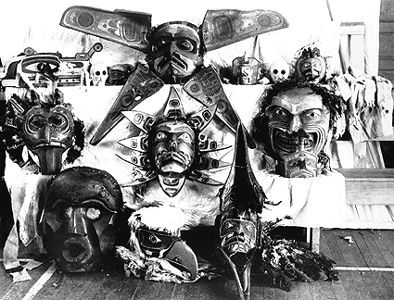
A collection of dance masks. Photo taken in an Anglican Church parish hall in Alert Bay, British Columbia. Reference code H-03994, 1922. Photographer: William Halliday. Courtesy Royal BC Museum and Archives, Victoria, Canada
Of all of the photos of the confiscated items from the Alert Bay potlatch ceremonies, this one circulates most. Masks perform different roles in the potlatch. Of those pictured, some are chiefs’ headdresses; others are not worn but displayed at the appropriate time as a sign of high rank; the remainder are danced. In the centre of the image are the transformation masks, created with elaborate pulley systems. Their wearers switch between different beings mid-performance, thus enacting the thin line between the human and the spirit worlds. Here, these masks are displayed in a fixed position, open with their inner faces exposed. The large mask shown in the lower-left corner of the photograph is of Dzunuk’wa, the wild woman of the woods. She is often carved with her mouth open and adorned with a mess of long, black hair. She is a cannibal, capturing children in her cedar basket for later eating. On either side of the upper ledge are carved skulls. Representations of life and death are integral to potlatch ceremonies.
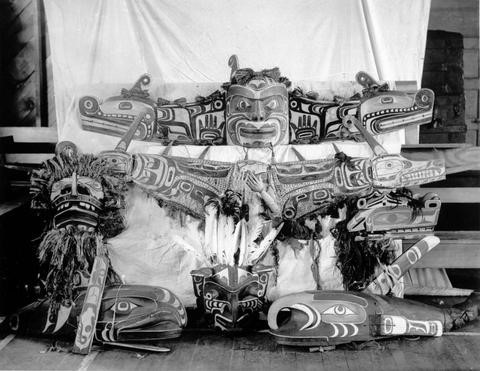
Indian ceremonial masks, Alert Bay, British Columbia. Photographer unknown. Reference code: D-02021. Courtesy Royal BC Museum and Archives, Victoria, Canada
The objects taken from the Memkumlis village and surrounding communities are gathered together like sinners in the Anglican Parish Hall in Alert Bay. Arranged on white sheets by Indian Agent William Halliday, the masks in the photograph are presented as evidence of supposedly fugitive practices. The photographs exist because of the ban, but they are another kind of evidence as well – that of the white obsession with the potlatch. When the masks were shipped from Village Island to Alert Bay and assembled in the church, they became commodities. Before the objects were dispersed, viewers paid admission to view the goods on display in the parish hall. Treated with relative indifference in the 1860s, by the 1870s they were ‘the subject of a moral crusade’.[8] Now trafficable objects, they entered the holdings of museums via Halliday, and were then sold to individuals including George Gustav Heye and Andre Breton; a small number remained in the personal collection of Indian Agent Duncan Campbell Scott. While the potlatch was described as ‘worthless’ by Indian Agents, the masks clearly were not. Taken from the hands of their rightful owners, they became commodities, and later vessels for others to project their ideas of the supernatural, of the primitive and the surreal. They began to stand in for the limits of European knowledge.
Central to this image are two large masks. Spread out, they reveal three faces: two on the outside and one, human-like, in the centre. The masks are of Sisiyut?, the two-headed serpent. Always depicted with horns, the creature turns those who cannot face their own fears into stone. Perhaps in line with its double-headed nature, Sisiyut? also bestows power and wealth – warriors and chiefs still employ his image as a crest on their regalia for protection.
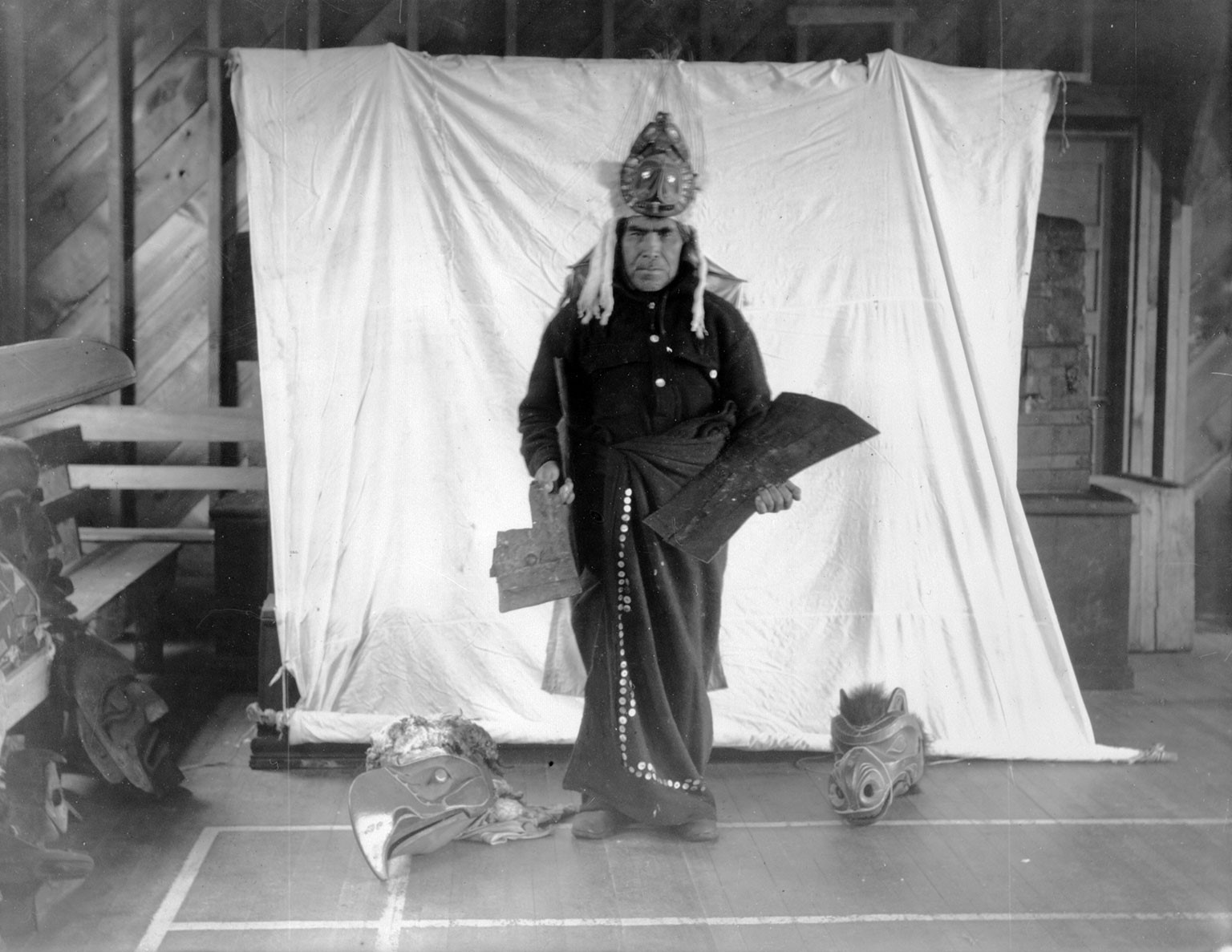
John Drabble with potlatch items at the Alert Bay, BC, Anglican Church parish hall. Reference code: H-03974, ca. 1922. Courtesy Royal BC Museum and Archives, Victoria, Canada
Halliday’s evidence of fugitive practices included people along with the objects he sought. In this photograph, a chief holds two T?akwa, or coppers, a whole and a partial piece. T?akwa are cut for specific reasons – either as an act of shaming or to demonstrate the status of a chief who bestows a cut portion of the top of the copper to his primary rival. On 16 April 1919, an Alert Bay man named Wawip?igesuwe wrote a letter on behalf of the ‘Namgis First Nation to petition the potlatch ban. In it, he appealed to Western economic models as a way of explaining the value of T?akwa:
Each tribe has its own coppers, and each copper has its own value. In the old days there was no money and these coppers were a standard of value but increased in value each time they changed hands. When the white man came and we could earn wages in cash for our labour we invested our savings in coppers and used them the same as a white man would do with a bank and would always expect more back then we put in. We are giving you a list of the coppers belonging to the ‘Namgis Tribe and their values, other tribes have their own coppers so that you will see the great financial loss that would entail on us if our custom is suppressed.[9]
The object was now doubly invested, with both cultural value and an economic one, in the Western economic sense, and this value continued to accrue the more that the coppers circulated. This great investment didn’t transfer with the coppers confiscated in 1922, however. Unlike the masks and regalia, no compensation was given to the owners of the coppers, since they were not assigned a dollar value in Indian Agent ledgers.
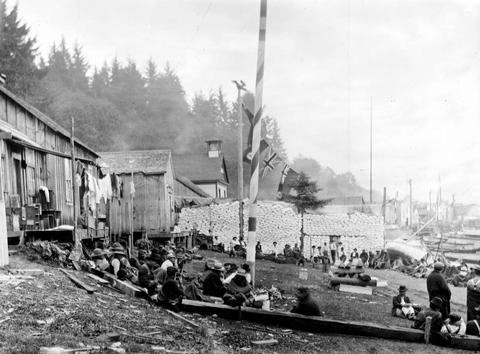
Scene at Alert Bay: bags of flour to be given away at a potlatch. Reference code H-03980. Courtesy Royal BC Museum and Archives, Victoria, Canada
During the ban, potlatches went underground, where their outward character was disguised. At times, potlatch goods were given at Christmas time as ‘presents’, while in the 1930s communities began hosting deliberately disjointed ceremonies: dances and speeches were held on separate days from the distribution of goods (gift-giving was banned when undertaken in the context of ceremony). At other times, potlatches were modelled on the giving of relatively banal European goods: the 1500 sacks of flour in this image, for instance. In place of the usual potlatch rituals that accompanied distribution, when giving the sack of flour shown here, the offerer simply said, ‘Here is some flour to help you over the hard winter.’ Christian ideas of charity were also added to the ceremony to dispel any concerns over questionable behaviour. This was a calculated decision, given that these Native communities had notoriously resisted assimilation to Christianity. Nevertheless, this choice provided the guise of conversion while the communities quite transparently carried on their own spiritual practices. When 900 sacks of flour were given away in Fort Rupert in 1933, the police were told: ‘[I]t was an act of Christian charity.’ Given the number of sacks (implying the great wealth of the person who purchased them), their deliberate display beforehand, and the communal gathering, the giving of flour was likely a means to repay a debt owed to another family because of a recent marriage, or a change of status. In this sense, the potlatch, reframed, brought about another crisis in colonial logic. Indian agents were well aware that this was a potlatch, yet the strict description of the ceremony in their documents could not account for the changes in form and the inherent creative resistance. What the whites had worked so hard to name had once again evaded their definitions; springing out of the colonial shadows of language and law, the potlatch necessitated yet another correction, another form of control.
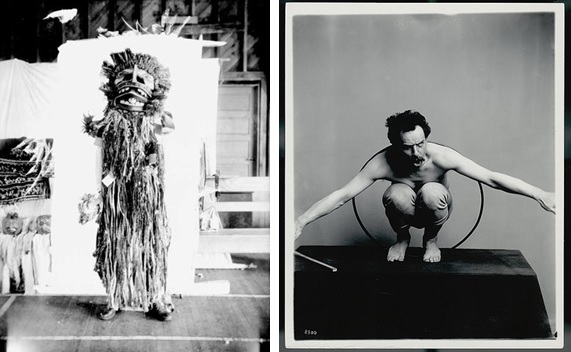
Left: A potlach dancer in regalia. Photo taken at the Anglican Church Parish Hall in Alert Bay, BC. Reference code: H-03977 Archives code(s): HP099695. Courtesy Royal BC Museum and Archives, Victoria, Canada
Right: Photographer: Anonymous. Date: Not recorded; 1895 or before. Notations on back of photograph of exhibit (USNM Kwakiutl no Number): ‘U.S.N.M. Rept. (1895) Plate 29 Hamats'a coming out of secret room’, and ‘Kwakiutl Indian ceremony for expelling cannibals’. Cited as: Negative MNH 8300, National Anthropological Archives, Smithsonian Institution. Local number: OPPS NEG MNH 8300
Much of what was written about the Hamat’saceremony – the secret society that purportedly involved the ritualistic eating of human flesh – is used as evidence of the savagery of Native people and further justification for the criminalisation of the potlatch. Originally held as part of Tsetseka, or winter ceremonials, young male initiates enacted their possession of the man-eating spirit Baxbaxwalanuxsiwae’. Over the course of the ceremony, the young men are rid of the spirit. The Hamat’sa was central for Kwakwaka’wakw to reiterate the power of the living relative to the dead (the ability to consume the dead, while not succumbing to death), and to the wild forces of nature. There is another form of reciprocity at work here, that being between the human world and the supernatural. While spirits are sacrificed to enable the survival of human life as a part of the ceremony, the very offering of human life signified through the simulated eating of flesh is understood as necessary to enable the ongoing survival of the supernatural. The ceremonies of the potlatch brought about another form of possession as well – that of the Indian Agents and perhaps even of the anthropologist Franz Boas himself.
On the left, Boas is seen modelling for a diorama on the Hamat’sa. He is depicted as the ‘wild’ dancer emerging from the threshold of the supernatural and out of the mouth of Baxbaxwalanuxsiwae’. The diorama itself was based on an enactment of the ceremony that was very much out of time. In 1893 a group of Kwakwaka’wakw were brought to Chicago as part of the World Columbian Exposition. Here they performed the Hamat’sa over and over again to an uninitiated audience, setting in motion a cycle of repetition and reiteration of the ritual that carries through to the present.
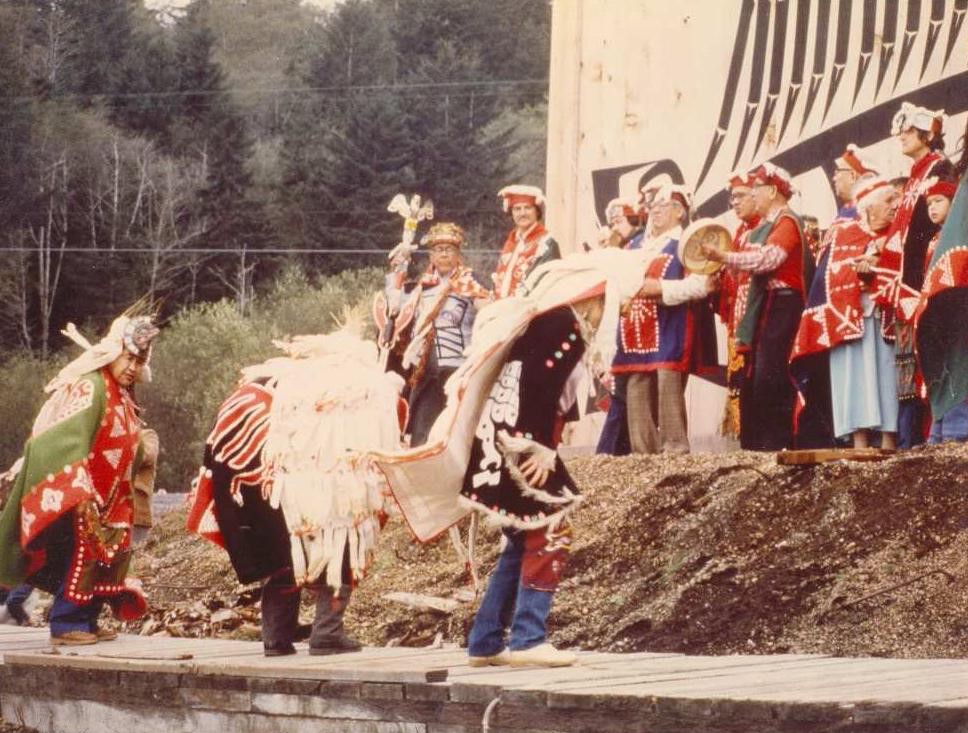
© Vickie Jensen/U’mista Cultural Society, U'mista Cultural Centre, Alert Bay, British Columbia
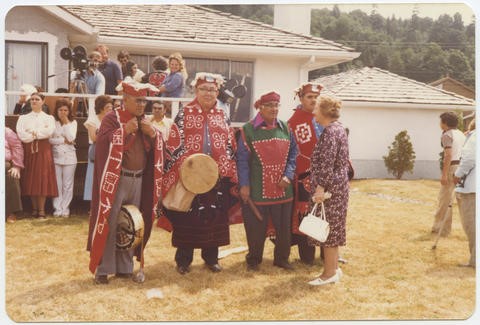
Nuyumbalees Museum, Alert Bay, British Columbia. Images courtesy Royal BC Museum and Archives, Victoria, Canada. Item: J-00559
The Kwakwaka’wakw people make clear that dance is not only a celebration; it is an integral part of their judicial system and governance. They declare that: ‘a strict law bids us to dance’.[10] In 1975, when the return of the first set of objects taken after the potlatch of 1921 was made official, people in Cape Mudge and Alert Bay celebrated with dances that were not simply celebratory.
Part of the agreement for the objects to come home was that they had to be housed in museums. With this came an opportunity for the community to rethink the role of the museum, and how it might display objects and present their complicated stories.
At U’Mista Cultural Centre in Alert Bay, the objects are arranged around an open area within the architecture of a large house. They are not placed in vitrines but out in the open, grouped together and arranged in approximately the same order as they would take in the potlatch. An emphasis is placed on the meanings of different masks and regalia with a continual reiteration of their relationship to the 1921 potlatch and the Cranmer family. In the Nuyumbalees Cultural Centre, the emphasis of the display is on the individual families who are the caretakers of the specific objects. The 1921 potlatch was not Dan Cranmer’s alone, but a collaborative venture with his wife Emma, as well as Cape Mudge Chief Billy Assu. Unlike at U’Mista, the main audience in Cape Mudge remains the community.
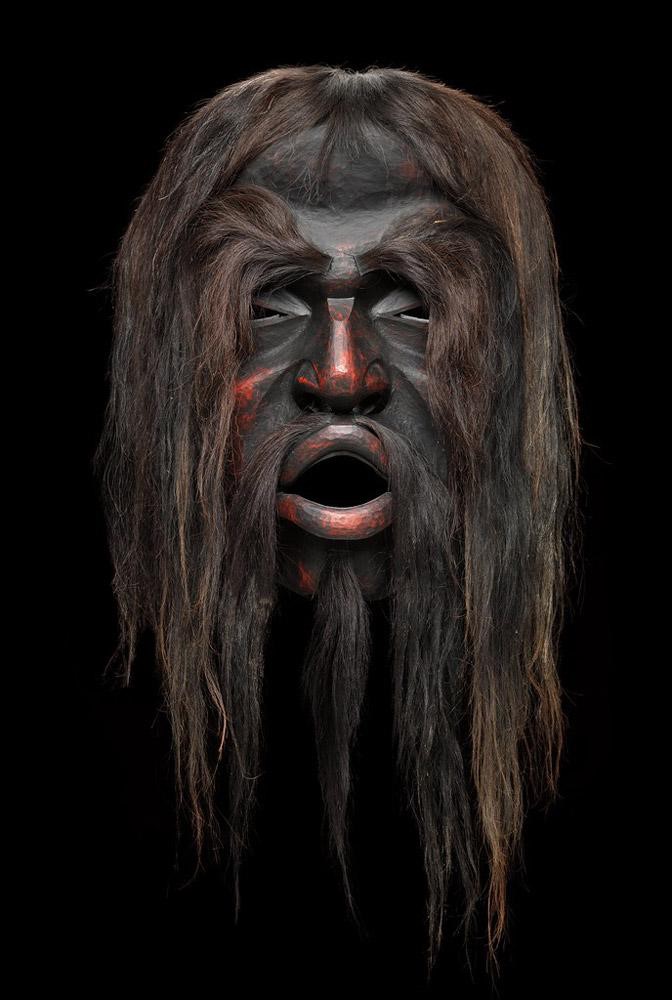
Beau Dick, Tsonokwa Mask, 2007. Red cedar, horse hair and acrylic, 78.8 x 66.1 x 35.6 cm. Collection Michael Audain and Yoshiko Karasawa. Photo by Trevor Mills
Despite the predictions of authorities and policy makers that the potlatch would disappear, which at the height of the ban were constantly repeated by policy makers and by the accused (as a way to placate the authorities), the potlatch never died. As a system, it proved remarkably malleable. At times it was split into two parts, strategically incorporating European goods and ideologies as a disguise or going underground, while remaining very much itself. Potlatch objects circulate now mainly in the form of masks: some are carved specifically for the art market; others circulate as part of a ceremony. Beau Dick is a maker of masks. Of Kwakwaka'wakw descent, he lives and works in Alert Bay. The frequent subject of his carvings, many of which are sold to collectors, is Dzunuk’wa, the cannibal. In this context, eating the other is a stand-in for cultural consumption. In 2012 Dick tried to short-circuit this desire for consumption when he removed forty of his masks from the walls of his commercial gallery in Vancouver and took them back to his home community, where they were ceremonially burned in front of witnesses who included artists and collectors. The burning of the masks was not simply an act of destruction, but set in motion the creation of a new set of masks, which after their four years of use in potlatch will also be set ablaze.
There is a story about a community of people who decided to do something about Dzunuk’wa, so they captured and killed her. To ensure that she wouldn’t come back to life, they built a large fire to burn her body. At the moment her body was scorched and black, she transformed into a swarm of mosquitoes. The transformation and dispersion of Dzunuk’wa is something like the potlatch itself – a practice that survived because of its own transmutations during the apex of colonial violence and control.
‘Outlawed Social Life’ by Candice Hopkins was originally published in the South as a State of Mind (Issue #7 [Documenta 14 #2], 2016) and is republished with kind permission of the journal Editor Marina Fokidis, Documenta 14 Artistic Director Adam Szymczyk and Editor-in-Chief Quinn Latimer.
[1] Franz Boas, from an 1889 report to the Geographical Society of Berlin cited in Christopher Bracken, The Potlatch Papers: A Colonial Case History (Chicago and London: The University of Chicago Press, 1997), p. 6.
[2] Ibid., p. 8.
[3] Christopher Bracken, The Potlatch Papers, p. 46.
[4] Jacques Derrida, Glas (Lincoln: University of Nebraska Press, 1986), p. 6–7.
[5] An Act further to amend ‘The Indian Act, 1880’, sc 1884, c. 27, s.
[6] Christopher Bracken, The Potlatch Papers, pp. 42–43.
[7] Michael Ames, Cannibal Tours and Glass Boxes: The Anthropology of Museums (Vancouver: University of British Columbia Press, 1992) pp. 139–50.
[8] Christopher Bracken, The Potlatch Papers, p. 35.
Download this article as PDF
Candice Hopkins
Candice Hopkins is a curator and writer originally from Whitehorse, Yukon, and based in Albuquerque, New Mexico. She is co-curator of the forthcoming SITE Santa Fe biennial, Casa Tomada, as well as co-curator of the Canadian Pavilion at the 58th Venice Biennale. She was a curator for documenta 14 in Athens, Greece, and Kassel, Germany. Hopkins’s writing is published widely and recent essays include ‘Outlawed Social Life’ for South as a State of Mind and ‘The Gilded Gaze: Wealth and Economies on the Colonial Frontier’ for the documenta 14 Reader. She is the recipient of several awards and has lectured on contemporary art, sound, indigeneity, native economies and vernacular architecture. Hopkins is a citizen of Carcross/Tagish First Nation.
- Introduction: Beautiful world, where are you?
Joasia Krysa - Beauty: A Logistical Imaginary [1]
Jussi Parikka - Excerpt from ‘Climate Grief and the Visible Horizon’
Meehan Crist - Outlawed Social Life
Candice Hopkins - Re-figuring Ourselves – A Conversation
Morehshin Allahyari & Christiane Paul - Forensic Aesthetics
Eyal Weizman - Technology, magic and the quest for meaning
Ryan Avent - Self-repairing Cities
Mark Miodownik - Alien Speak: Linguist Dr Jessica Coon on Villeneuve’s ARRIVAL
Jessica Coon - Outside the Hit Factory: The Playlist
Alexander Provan - Colophon